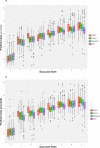High throughput estimates of Wolbachia, Zika and chikungunya infection in Aedes aegypti by near-infrared spectroscopy to improve arbovirus surveillance
- PMID: 33452445
- PMCID: PMC7810739
- DOI: 10.1038/s42003-020-01601-0
High throughput estimates of Wolbachia, Zika and chikungunya infection in Aedes aegypti by near-infrared spectroscopy to improve arbovirus surveillance
Abstract
Deployment of Wolbachia to mitigate dengue (DENV), Zika (ZIKV) and chikungunya (CHIKV) transmission is ongoing in 12 countries. One way to assess the efficacy of Wolbachia releases is to determine invasion rates within the wild population of Aedes aegypti following their release. Herein we evaluated the accuracy, sensitivity and specificity of the Near Infrared Spectroscopy (NIRS) in estimating the time post death, ZIKV-, CHIKV-, and Wolbachia-infection in trapped dead female Ae. aegypti mosquitoes over a period of 7 days. Regardless of the infection type, time post-death of mosquitoes was accurately predicted into four categories (fresh, 1 day old, 2-4 days old and 5-7 days old). Overall accuracies of 93.2, 97 and 90.3% were observed when NIRS was used to detect ZIKV, CHIKV and Wolbachia in dead Ae. aegypti female mosquitoes indicating NIRS could be potentially applied as a rapid and cost-effective arbovirus surveillance tool. However, field data is required to demonstrate the full capacity of NIRS for detecting these infections under field conditions.
Conflict of interest statement
The authors declare no competing interests.
Figures




Similar articles
-
Rapid and Non-Invasive Detection of Aedes aegypti Co-Infected with Zika and Dengue Viruses Using Near Infrared Spectroscopy.Viruses. 2022 Dec 20;15(1):11. doi: 10.3390/v15010011. Viruses. 2022. PMID: 36680052 Free PMC article.
-
wMel limits zika and chikungunya virus infection in a Singapore Wolbachia-introgressed Ae. aegypti strain, wMel-Sg.PLoS Negl Trop Dis. 2017 May 19;11(5):e0005496. doi: 10.1371/journal.pntd.0005496. eCollection 2017 May. PLoS Negl Trop Dis. 2017. PMID: 28542240 Free PMC article.
-
The wMel Strain of Wolbachia Reduces Transmission of Chikungunya Virus in Aedes aegypti.PLoS Negl Trop Dis. 2016 Apr 28;10(4):e0004677. doi: 10.1371/journal.pntd.0004677. eCollection 2016 Apr. PLoS Negl Trop Dis. 2016. PMID: 27124663 Free PMC article.
-
Mission Accomplished? We Need a Guide to the 'Post Release' World of Wolbachia for Aedes-borne Disease Control.Trends Parasitol. 2018 Mar;34(3):217-226. doi: 10.1016/j.pt.2017.11.011. Epub 2018 Jan 23. Trends Parasitol. 2018. PMID: 29396201 Review.
-
Aedes vittatus (Bigot) mosquito: An emerging threat to public health.J Vector Borne Dis. 2017 Oct-Dec;54(4):295-300. doi: 10.4103/0972-9062.225833. J Vector Borne Dis. 2017. PMID: 29460858 Review.
Cited by
-
Malaria absorption peaks acquired through the skin of patients with infrared light can detect patients with varying parasitemia.PNAS Nexus. 2022 Dec 7;1(5):pgac272. doi: 10.1093/pnasnexus/pgac272. eCollection 2022 Nov. PNAS Nexus. 2022. PMID: 36712329 Free PMC article.
-
Identification of visible and near-infrared signature peaks for arboviruses and Plasmodium falciparum.PLoS One. 2025 Apr 17;20(4):e0321362. doi: 10.1371/journal.pone.0321362. eCollection 2025. PLoS One. 2025. PMID: 40244986 Free PMC article.
-
Near-infrared spectroscopy and machine learning algorithms for rapid and non-invasive detection of Trichuris.PLoS Negl Trop Dis. 2023 Nov 13;17(11):e0011695. doi: 10.1371/journal.pntd.0011695. eCollection 2023 Nov. PLoS Negl Trop Dis. 2023. PMID: 37956181 Free PMC article.
-
Invasive hematophagous arthropods and associated diseases in a changing world.Parasit Vectors. 2023 Aug 17;16(1):291. doi: 10.1186/s13071-023-05887-x. Parasit Vectors. 2023. PMID: 37592298 Free PMC article. Review.
-
Rapid and Non-Invasive Detection of Aedes aegypti Co-Infected with Zika and Dengue Viruses Using Near Infrared Spectroscopy.Viruses. 2022 Dec 20;15(1):11. doi: 10.3390/v15010011. Viruses. 2022. PMID: 36680052 Free PMC article.
References
MeSH terms
LinkOut - more resources
Full Text Sources
Other Literature Sources

